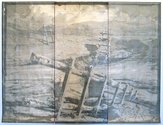John Hurrell – 10 April, 2010
The artist has digitally bended these images together, often including small human forms, or ladders constructed from HB pencils - with shadows. There is a reflexive humour here because these scanned images are in fact drawn with a computer using parallel pencil lines.
Auckland
Peter Gibson Smith
Buried
31 March - 24 April 2010
At Bath St, Peter Gibson Smith presents nine landscapes that are startlingly distinctive as images. They look like antique photographs that close up appear to have been made into line engravings and then transferred on to thin paper sheets supported by curved cross-sections of balsa and cardboard bracing.
Most of these works are in two or three vertical sections butted together. They have alternating curved ends that either project out into the room, or else bend towards the wall. These generate shadows that tonally liven up the austere fissure lined volcanic backgrounds of the work, for these pale landscapes incorporate famous Burton Brothers photographs of bare tephra-caked hills just after the 1886 Mt.Tarawera eruption. In their centres they have superimposed dramatic images of ancient monuments or earlier Gibson Smith sculptures.
The artist has digitally bended these images together, often including small human forms, or ladders constructed from HB pencils - with shadows. There is a reflexive humour here because these scanned images are in fact drawn with a computer using parallel pencil lines. They are then coated with brown encaustic that softens the pencil tones by mottling and darkening the graphite hatching. Sometimes rare touches of colour are added to the paper surface, or painted on the sides.
Because the paper is thin and stretched over the ribbed struts of the balsa stretcher, the delicate waxy images look, and are, frail, with the supporting trellis being clearly detectable behind the marks. The pencil lines are horizontal and vertical in the pale grey zones, with gaps along the lengths and spatial variations sometimes between them. Like a printing method, extra diagonal hatching is superimposed for the darker areas.
All this makes Gibson Smith’s images intriguing. They are haunting in a classic surrealist sense; a landscape hybrid of Max Ernst and Joel Peter Witkin. This is easily the best work of his career so far, possibly because he is avoiding colour (for which in my view he has no aptitude) but also because there is a relaxed looseness about the blotchy forms and overlaid rectangles. They are ambiguous spatially and far less fiddly than his previous projects.
Although there is an amusing logic in his rendering of massive monuments on wobbly paper on fragile supports, the fact they are in sections is a weakness - creating an irritating distraction through their painted edges. The vertical divisions seem to be the result of the width limitations of his drawing machine.
Where Gibson Smith succeeds is in establishing a humour where the works appear at a distance to be screened photographs sourced from museum collections. As mentioned, the precision and regularity of the pencil lines are akin to line engravings, though he teases with methods of registration too by having some layers of dark hatching deliberately out of sync.
I personally tend to be indifferent to technical innovation - because that aspect is invariably besides the point with good art - but these images do fascinate as complex systems of rendered marks, and as dreamlike narratives. Their programming makes them distantly related to Simon Ingram with his ‘robot’ painting, and also Stephen Greenwood, an artist who exhibited the products of his drawing machine in Christchurch’s Gingko gallery in the mid-eighties. (Before computers were available, he invented a machine that used an electric eye to scan still lifes, rendering them with horizontal lines made with coloured marker pens.)
With Gibson Smith the ominous darker works are especially memorable, especially a small image of some rocks (and ghostly traces of an airborne contraption) in a cloud-filled sky, and two large drawings, one of a shed-like, ruined arch of stacked books, the other of a statue of a lion attacking a horse (related to George Stubbs).
The method of mark making builds on their enigmatic character by amplifying the oddness of the shockingly destroyed New Zealand landscape now coping with new unexpected insertions dropped into its midst. It makes compelling viewing to see drawing, photography, painting and sculpture blended in such an innovative fashion.
Recent Comments
Igor Lukyanov
This is really something unusual. An interesting idea implemented by a talented artist.






 Two Rooms presents a program of residencies and projects
Two Rooms presents a program of residencies and projects Advertising in this column
Advertising in this column



This Discussion has 1 comment.
Comment
Igor Lukyanov, 4:10 p.m. 11 April, 2010 #
This is really something unusual. An interesting idea implemented by a talented artist.
Participate
Register to Participate.
Sign in
Sign in to an existing account.